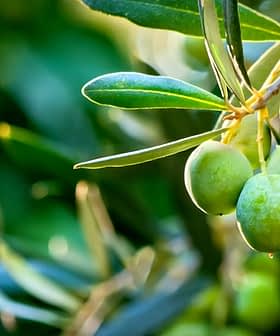Tough Season in California
The tale of the California olive crop is one of survival, but as this season is showing it can also be the pits.
From Corning in the Sacramento Valley to Lindsay in the San Joaquin this year’s table olive crop is a serious disappointment, although production in the northern section is expected to be closer to normal volume. A short winter cold snap, severe heat during spring bloom, plus more heat and little water during the growing season have severely reduced the crop in Tulare County. Prices for the canned product are sure to rise, but nobody in the industry expects them to compensate for the lack of tonnage.
See Also:Complete Coverage of the 2014 Harvest
Even traditional processing systems are part of the equation. Each olive destined for canning, whether green or black, must be cured. Curing involves a dip in a caustic solution to counteract the fruit’s natural bitterness, plus soaking in brine for an extended period before being sealed in cans or jars.
The dismal side of olive processing for the consumer market is that both the caustic solution and the brine must be disposed of. That has been a challenge for olive canners from the outset of the industry, and the cause of some bitter legal entanglements and environmental disputes. One processor has installed state-of-the art equipment to purify the liquids beyond their natural state, and others are following.
Acreage statewide has declined slightly over the past five years, causing volumes of raw product to diminish. Most of the state’s orchards are aging or already aged, with some having been uprooted in the past five years, replaced by other tree crops.
Foreign competition has been a major factor in the marketing of canned olives also. Supplies from Italian, French, Spanish and Moroccan orchards can be imported, mostly by pizza chains, at prices below the American product. American marketers can criticize the quality, even the taste, of imported olives, but when scattered on pizzas they defy discrimination by the teen-age, pizza-eating crowd.
In what was hoped to be a redeeming and exciting aspect of the state’s olive industry, olive oil production, has expanded markedly in the past eight to 10 years. Thousands of acres of trees have been planted for that purpose. Exotic equipment, much of it imported, has been installed to extract the oil, and designer labels are appearing that challenge wine labels for graphic extravagance. Taking another page from the wine industry’s marketing technique, olive oil producers have opened tasting rooms, calculated to attract traveling visitors, some in locations as picturesque as the labels on the designer bottles.
Promotional campaigns are already operating to extol the superior quality, purity and taste of the oil being produced from California olives. New grading standards have been established, olive oil connoisseurs are cropping up, and the food and beverage publications are featuring the quaintness of hillside olive orchards and the taste of their products.
See Also:California Olive Ranch Negotiating to Buy Importer Lucini
But even in that enthusiastic atmosphere at least one high-volume oil producer operating in an efficient crushing facility with shiny new equipment has folded. He bought olives from established growers at prices beyond those he could realize from the bottled product.
The boom in olive oil production is partly the result of some recently developed varieties, usually planted in trellised fashion only inches apart, using converted wine grape harvesting equipment. It straddles each row and shakes the fruit from the trees into moving conveyors and then to accompanying trailers for transport for crushing.
While some disappointment, even dejection, prevails in the segment of the California olive industry that produces those tasty olives to grace our holiday tables and summer picnic outings, the oil-producing segment of the industry anticipates a growing, even thriving and profitable future. These days a person in California’s olive industry might be at any level, from the pits to the pinnacle.









